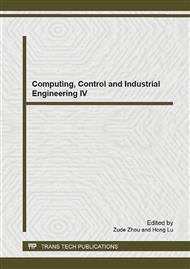[1]
M. Tan, S. Wang and Z. Q. Cao: Multi-Robot System. (Tsinghua University Press, China 2005).
Google Scholar
[2]
L. Jin, C. B. Ni, Y. Q. Yang and Z. Q. Cao: Study on Q-Learning of Multi-robot Systems Based on Community Perception Networks. International Conference on Mechanic Automation and Control Engineering, Baotou, 2012: 511-515.
Google Scholar
[3]
S. Alberto, H. Norihiro and S. Alessandro: Network Robot Systems, Robotics and Autonomous Systems, 2008, 56(10): 793-797.
Google Scholar
[4]
Information on http: /urus. upc. es/index. html.
Google Scholar
[5]
T. Kanda, M. Shiomi and Z. Miyashita: A Communication Robot in A Shopping Mall. IEEE Transactions on Robotics, 2010, 26(5): 897-913.
DOI: 10.1109/tro.2010.2062550
Google Scholar
[6]
S. Chao S, T. Kanda and M. Shimada: Easy Development of Communicative Behaviors in Social Robots. IEEE/RSJ International Conference on Intelligent Robots and Systems, 2010: 5302-5309.
DOI: 10.1109/iros.2010.5650128
Google Scholar
[7]
J. Shen, G. Gu and H. Liu: A Survey of Hierarchical Reinforcement Learning. Pattern Recognition and Artificial Intelligence, 2005, 18(5): 574-581.
Google Scholar
[8]
Y. Q. Yang, L. Jin, Z. Q. Cao and C. B. Ni: A Survey of Reinforcement Learning Research and It's Application for Multi-robot Systems. Proceedings of the 31st Chinese control Conference, 2012: 3068-3074.
Google Scholar
[9]
L. Jin, Y. Q. Yang, C. B. Ni, Z. Q. Cao and X. R. Tang: Study on Online εNN Q-learning Based on Community Perception Network. Lecture Notes in Electrical Engineering, 2013, in press.
DOI: 10.1007/978-3-642-38524-7_96
Google Scholar
[10]
L. Liu and L. Li: Hierarchical Regional Cooperative Q-learning. Computer Engineering and Application, 2009, 45(22): 7-9.
Google Scholar
[11]
Y. Zhu and J. Mao: Robot's Behavioral Decision Making Strategy Based on Artificial Emotion and Q-learning, Intelligence Engineering, 2011: 61-65.
Google Scholar
[12]
Q. Song and Z. Hu: Q-learning Based on The Experience Knowledge. Techniques of Automation and Applications, 2006, 25(11): 10-12.
Google Scholar
[13]
J. Hu and Q. Zhu: Path Planning of Robot for Unknown Environment Based on Prior Knowledge Rolling Q-learning. Control and Decision, 2010, 25(9): 1364-1368.
Google Scholar
[14]
C. Du, Y. Gao and W. Zhang: Q-learning With Prior Knowledge in Multi-agent Systems. Journal of Tsinghua University (Sci & Tech), 2005, 45(7): 981-984.
Google Scholar
[15]
H. Zhang, H. Chen and Z. Liu: Application of The Experience-shared Distributed Q-learning Model in Robcup. Artificial Intelligence, 2010, 26(3-2): 25-26.
Google Scholar
[16]
C Chang, X. Yin and Y. Bao: A Shared Experience Tuples Multi-agent Cooperative Reinforcement Learning Algorithm. Pattern Recognition and Artificial Intelligence, 2005, 18(2): 234-239.
Google Scholar


